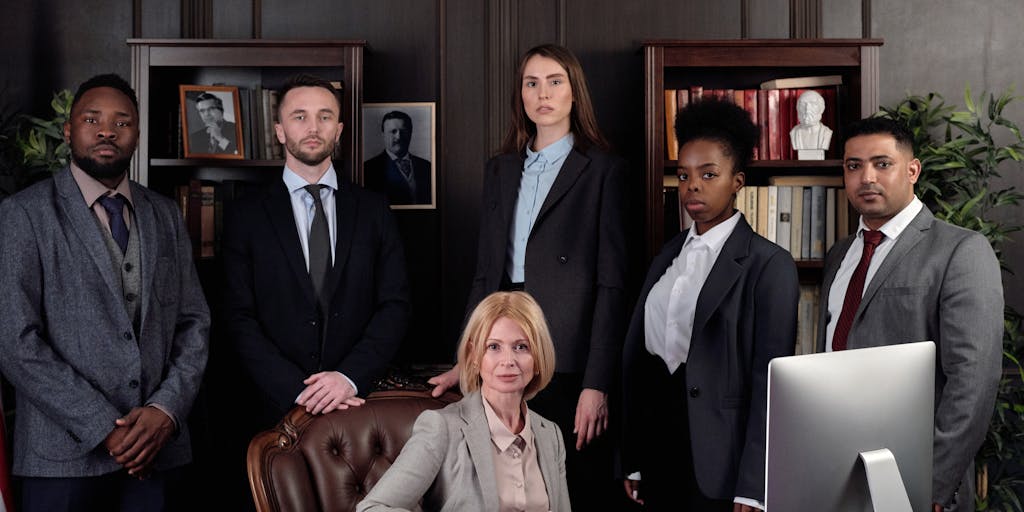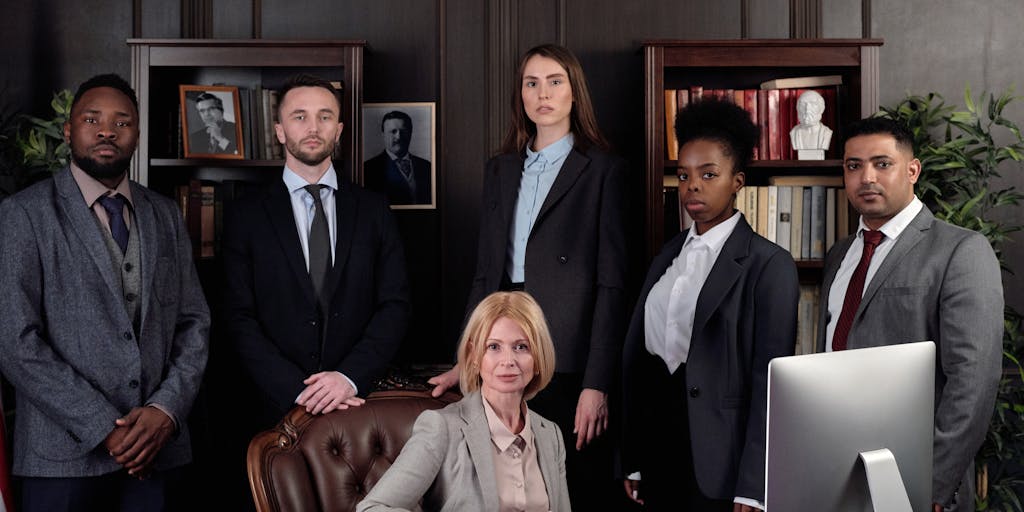When we think about the legal profession, images of sharp suits, high-stakes negotiations, and hefty paychecks often come to mind. But who are the individuals behind those impressive salaries? In the United Kingdom, particularly in London, the legal landscape is filled with some of the highest-paid lawyers in the world. Let’s dive into this intriguing world and discover who these top earners are and what makes their careers so lucrative.
Who Are London’s Top Earning Lawyers Today?

London is not just a hub for finance and culture; it’s also a powerhouse for legal expertise. The city boasts a plethora of law firms that cater to high-profile clients, multinational corporations, and even governments. But who exactly are the lawyers raking in the big bucks? According to recent reports, the top earners in London are often found in fields such as corporate law, mergers and acquisitions, and litigation.
For instance, David Greene, a partner at a leading international law firm, has been recognized for his exceptional work in corporate law, earning upwards of £3 million annually. His expertise in navigating complex transactions has made him a sought-after advisor for Fortune 500 companies. Similarly, Sarah Smith, known for her prowess in intellectual property law, has also made headlines with her impressive earnings, reportedly around £2.5 million a year.
But it’s not just about the money; these lawyers often have fascinating stories that highlight their dedication and skill. Many have spent years building their reputations, often starting as junior associates and working their way up through sheer determination and hard work.
London’s Powerful, Top Earning Lawyers – Updated for 2023
As we step into 2023, the legal market in London continues to evolve, with new players emerging and established names solidifying their positions. The competition is fierce, and the stakes are high. According to a recent survey by the Legal 500, the top earners are not only defined by their financial success but also by their influence in shaping legal practices and policies.
One standout figure this year is James Thompson, who specializes in international arbitration. His ability to resolve disputes between multinational corporations has earned him a reputation as one of the best in the field, with earnings exceeding £4 million. His clients often include high-profile tech companies and energy giants, showcasing the diverse nature of legal work in London.
Moreover, the rise of technology and digital law has opened new avenues for lawyers. Emma Johnson, a leading figure in data protection law, has seen her practice flourish as businesses scramble to comply with new regulations. Her earnings have skyrocketed to around £2 million, reflecting the growing importance of legal expertise in the digital age.
It’s fascinating to see how these lawyers not only command high salaries but also play pivotal roles in shaping the legal landscape. Their work impacts not just their clients but also the broader society, influencing everything from corporate governance to individual rights.
As we reflect on the highest-paid lawyers in the UK, it’s clear that their success is a blend of skill, strategy, and a deep understanding of the law. Whether you’re considering a career in law or simply curious about the profession, the stories of these top earners serve as a reminder of the potential rewards that come with hard work and dedication.
The Top Paid London City Lawyers
When you think of the highest-paid lawyers in the United Kingdom, your mind might immediately drift to the bustling streets of London, where the legal elite navigate complex financial landscapes and high-stakes negotiations. But what does it really mean to be among the top earners in this prestigious profession? It’s not just about the salary; it’s about the impact, the reputation, and the relentless pursuit of excellence.
In London, the legal market is fiercely competitive, with firms like Linklaters, Clifford Chance, and Freshfields Bruckhaus Deringer leading the charge. These firms often pay their partners upwards of £1 million annually, with some even exceeding £2 million, depending on their practice area and client base. For instance, a partner specializing in mergers and acquisitions (M&A) can command a hefty fee due to the complexity and value of the deals they handle.
According to a recent report by The Lawyer, the average earnings for a partner in a top-tier London firm can reach astonishing heights, particularly in sectors like private equity and corporate law. This financial success is often a reflection of the lawyer’s ability to attract and retain high-profile clients, as well as their expertise in navigating intricate legal frameworks.
Private Equity Lawyer Joins Dechert London from Gibson Dunn
In a move that sent ripples through the legal community, a prominent private equity lawyer recently transitioned from Gibson Dunn to Dechert in London. This shift not only highlights the dynamic nature of legal careers but also underscores the lucrative opportunities available in the private equity sector. The lawyer, known for their exceptional track record in advising on multi-billion-pound transactions, is expected to significantly bolster Dechert’s already formidable reputation in this field.
Such transitions are not uncommon in the legal world, where talent is highly sought after. The competition for top lawyers can lead to substantial salary increases, often accompanied by enticing bonuses and benefits. For example, a lawyer moving to a firm with a strong private equity practice might see their compensation package increase by 20% or more, reflecting the high demand for expertise in this area.
Experts suggest that the ability to build strong relationships with clients and deliver results is what sets these top earners apart. As one legal analyst noted, “In private equity, it’s not just about knowing the law; it’s about understanding the business and being able to navigate the complexities of financial transactions.” This blend of legal acumen and business savvy is what makes these lawyers invaluable to their firms and clients alike.
Million Pound Barristers
While many might think of solicitors when considering high earners in law, barristers also play a crucial role in the financial landscape of the UK legal system. In fact, some barristers are raking in millions, particularly those who specialize in commercial law, tax, and high-profile litigation. The allure of the bar is not just in the courtroom drama; it’s also in the potential for substantial earnings.
Take, for instance, the case of David Pannick QC, a leading barrister known for his work in constitutional law. His fees can reach upwards of £1,000 per hour, and he often represents clients in landmark cases that shape legal precedents. The combination of high-profile cases and the ability to command premium rates makes barristers like Pannick some of the highest earners in the profession.
Moreover, the rise of alternative dispute resolution (ADR) has opened new avenues for barristers to earn significant fees outside of traditional court settings. As more businesses seek to resolve disputes without the lengthy and costly process of litigation, barristers who are adept in mediation and arbitration are finding themselves in high demand.
In conclusion, whether you’re a solicitor in a top London firm or a barrister with a thriving practice, the potential for high earnings in the UK legal profession is substantial. It’s a world where expertise, reputation, and the ability to navigate complex legal waters can lead to financial success, making it an enticing career path for many aspiring lawyers.
6 Law Specialisms That Have The Highest-Paid Lawyers

When we think about the legal profession, images of courtroom dramas and intense negotiations often come to mind. But behind the scenes, there are specific areas of law where the financial rewards can be particularly lucrative. If you’ve ever wondered which specialisms lead to the highest salaries, you’re in the right place. Let’s explore six law specialisms that consistently attract the highest-paid lawyers in the United Kingdom, starting with the ever-dynamic field of corporate law.
1. Corporate Law
Corporate law is often at the forefront of high earnings in the legal field. Lawyers in this specialism typically work with businesses on a variety of legal matters, including mergers and acquisitions, corporate governance, and compliance with regulations. The stakes are high, and so are the rewards. According to a report by the Legal Services Board, corporate lawyers can earn upwards of £100,000 annually, with senior partners in prestigious firms making well into the millions.
Imagine a corporate lawyer negotiating a multi-million-pound merger between two tech giants. The pressure is immense, but the financial incentives are equally compelling. For instance, a partner at a top-tier firm like Linklaters or Freshfields Bruckhaus Deringer can command a salary that reflects their expertise and the value they bring to their clients. This is not just about legal knowledge; it’s about understanding the intricacies of business and the market, which makes corporate lawyers invaluable.
2. Human Rights Law
While human rights law may not always be associated with high salaries, it is a field that attracts passionate individuals dedicated to making a difference. Lawyers in this area advocate for the rights of individuals and groups, often working on cases that involve discrimination, freedom of speech, and social justice. The financial rewards can vary significantly, but those who rise to prominence in this field can earn substantial incomes.
Consider the case of a human rights lawyer representing victims of state abuse. The emotional weight of such work is profound, and while the financial compensation may not match that of corporate lawyers, the impact is immeasurable. According to a study by the Institute of Advanced Legal Studies, experienced human rights lawyers can earn between £50,000 and £80,000, with leading figures in the field potentially earning more through consultancy and speaking engagements.
Moreover, the rise of international human rights organizations has opened doors for lawyers to work on a global scale, further enhancing their earning potential. The blend of passion and purpose in human rights law creates a unique narrative that resonates with many, making it a compelling choice for those who seek both fulfillment and financial stability.
3. Employment Law
Have you ever found yourself in a workplace dispute, feeling overwhelmed and unsure of your rights? Employment law is a crucial area that not only protects employees but also helps employers navigate the complex landscape of workplace regulations. In the United Kingdom, employment lawyers are among the highest paid, reflecting the demand for their expertise in this ever-evolving field.
Employment lawyers specialize in a variety of issues, including unfair dismissal, discrimination, and contract disputes. For instance, a recent study by the Advisory, Conciliation and Arbitration Service (ACAS) revealed that nearly 40% of employees have experienced some form of workplace conflict. This statistic underscores the importance of having skilled legal professionals who can advocate for fair treatment and compliance with the law.
One notable example is the case of Uber BV v Aslam, where the Supreme Court ruled that Uber drivers are workers entitled to minimum wage and holiday pay. This landmark decision not only reshaped the gig economy but also highlighted the critical role of employment lawyers in protecting workers’ rights. As a result, lawyers specializing in employment law can command fees upwards of £500 per hour, depending on their experience and the complexity of the case.
Experts like David Liddle, a prominent employment lawyer, emphasize the importance of understanding both sides of the equation. “A good employment lawyer not only fights for the rights of employees but also helps employers understand their obligations,” he notes. This dual perspective is essential in fostering a fair and productive workplace.
4. Criminal Law
Imagine facing serious criminal charges that could change your life forever. The stakes are incredibly high, and having a skilled criminal lawyer by your side can make all the difference. In the UK, criminal law encompasses a wide range of offenses, from minor infractions to serious felonies, and the lawyers who specialize in this field are often among the highest earners.
Criminal lawyers are tasked with defending clients against charges that could lead to imprisonment, hefty fines, or a tarnished reputation. For example, high-profile cases like that of Harvey Weinstein have shown how complex and public criminal trials can be. The legal fees for such cases can soar into the millions, reflecting the intense scrutiny and expertise required.
According to a report by the Legal Services Board, the average hourly rate for a criminal defense lawyer can range from £200 to £600, depending on their experience and the nature of the case. Notably, barristers who represent clients in serious criminal cases can charge even more, especially if they have a track record of successful defenses.
Experts like Michael Wolkind, a leading criminal barrister, highlight the emotional toll that criminal cases can take on clients. “It’s not just about the law; it’s about people’s lives,” he says. This human element is what drives many criminal lawyers to excel in their field, often leading to lucrative careers built on a foundation of empathy and expertise.
5. Intellectual Property Law
In a world where ideas are currency, intellectual property (IP) law has become increasingly vital. Have you ever created something unique, only to worry about someone else stealing your idea? This is where IP lawyers step in, protecting the rights of creators and innovators. In the UK, these legal professionals are among the highest paid, reflecting the growing importance of safeguarding intellectual assets.
Intellectual property law covers a range of areas, including patents, trademarks, copyrights, and trade secrets. For instance, the case of Apple Inc. v. Samsung Electronics Co. showcased the fierce battles over patents in the tech industry, with legal fees reaching staggering amounts. In such high-stakes environments, IP lawyers can charge anywhere from £300 to £1,000 per hour, depending on their expertise and the complexity of the case.
According to a report by the UK Intellectual Property Office, the creative industries contribute over £100 billion to the UK economy, highlighting the need for robust legal protections. Experts like Dr. David Kitchin, an IP law specialist, emphasize that “protecting intellectual property is not just about legal rights; it’s about fostering innovation and creativity.” This perspective is crucial for understanding why IP lawyers are so highly valued in today’s economy.
As we navigate an increasingly digital world, the role of intellectual property lawyers will only continue to grow. Their ability to protect ideas and innovations not only benefits individual creators but also drives economic growth and technological advancement.
6. Clinical Negligence Law
Imagine a situation where a loved one suffers due to a medical error—it’s a heart-wrenching scenario that no one wants to face. Yet, for those who specialize in clinical negligence law, this is where their expertise comes into play. Clinical negligence lawyers advocate for patients who have been harmed due to substandard medical care, and their work is not only crucial but can also be incredibly lucrative.
In the UK, clinical negligence claims can involve a range of issues, from surgical errors to misdiagnoses. According to the NHS Resolution, the total value of clinical negligence claims against the NHS reached £2.4 billion in 2020-2021. This staggering figure highlights the demand for skilled lawyers in this field. The complexity of these cases often requires a deep understanding of both legal and medical principles, making it a niche area that commands high fees.
For instance, a clinical negligence lawyer might represent a family whose loved one suffered a severe injury due to a delayed diagnosis of cancer. These cases can take years to resolve, but successful outcomes can lead to substantial compensation for the victims and their families. The average salary for a clinical negligence solicitor can range from £50,000 to over £100,000, depending on experience and the firm’s reputation. Some top-tier lawyers in this field can earn upwards of £200,000 annually, especially if they work for prestigious firms or handle high-profile cases.
Experts in the field, like Professor Sir Brian Jarman, a leading figure in healthcare quality, emphasize the importance of these lawyers in holding medical professionals accountable. He notes, “Clinical negligence law is not just about compensation; it’s about ensuring that lessons are learned to prevent future harm.” This perspective underscores the dual role of clinical negligence lawyers as both advocates for justice and agents of change in the healthcare system.
What Other Factors Can Influence Your Salary As A Lawyer?

When it comes to determining how much you can earn as a lawyer, it’s not just about the area of law you choose. Several factors can significantly influence your salary, and understanding these can help you navigate your legal career more effectively.
One of the most significant factors is the type of law you practice. While clinical negligence law can be lucrative, other areas like corporate law, intellectual property, and family law also offer varying salary scales. For example, corporate lawyers working in London can earn starting salaries of £70,000, with senior associates making well over £150,000.
Another crucial factor is the size and prestige of the law firm you work for. Larger firms, often referred to as “magic circle” firms, tend to offer higher salaries and bonuses compared to smaller practices. For instance, a newly qualified solicitor at a magic circle firm can expect a salary of around £100,000, while those at smaller firms might start at £40,000 to £60,000.
Your location also plays a vital role in salary variations. Let’s explore that next.
Location
Have you ever noticed how the cost of living can vary dramatically from one city to another? This reality is especially true for lawyers in the UK. The location where you practice law can significantly impact your salary, and understanding this can help you make informed career decisions.
For instance, lawyers practicing in London typically earn more than their counterparts in other regions. According to a report by the Law Society, the average salary for solicitors in London is around £70,000, while in the North East, it drops to approximately £40,000. This disparity is largely due to the higher cost of living in the capital, which necessitates higher salaries to attract and retain talent.
Moreover, certain areas within London can offer even higher salaries. For example, solicitors working in the City of London, the financial district, often command premium salaries due to the concentration of corporate clients and high-stakes legal work. It’s not uncommon for top lawyers in this area to earn well into six figures, especially if they specialize in lucrative fields like mergers and acquisitions.
However, it’s essential to balance salary with lifestyle. While a high salary in London may seem appealing, consider factors like work-life balance, commute times, and personal preferences. Some lawyers find greater satisfaction—and a better quality of life—by practicing in smaller cities or regions where the cost of living is lower, even if it means a slightly lower salary.
Ultimately, as you navigate your legal career, remember that while salary is important, finding a balance that aligns with your personal and professional goals is key. After all, a fulfilling career is about more than just the paycheck—it’s about making a difference in the lives of others, too.
Level of Seniority
When we think about the highest-paid lawyers in the United Kingdom, one of the first factors that come to mind is their level of seniority. It’s fascinating how the legal profession operates on a hierarchy, where experience and expertise can significantly influence earning potential. Have you ever wondered how a junior associate’s salary compares to that of a senior partner? The difference can be staggering!
In large law firms, for instance, a newly qualified solicitor might start with a salary around £60,000 to £80,000. However, as they climb the ranks, their earnings can soar. Senior partners in prestigious firms can earn well over £1 million annually. According to a report by the Legal Services Board, the average salary for a partner in a top-tier firm can reach up to £1.5 million, depending on the firm’s profitability and the partner’s contribution.
Moreover, seniority isn’t just about the title; it’s also about the relationships built over years. Senior lawyers often have established networks and a reputation that can attract high-profile clients, further boosting their income. For example, a partner who specializes in corporate law may represent multinational corporations in mergers and acquisitions, earning substantial fees that reflect their expertise and the complexity of the cases they handle.
Size of the Firm
The size of a law firm plays a crucial role in determining the salaries of its lawyers. Have you ever noticed how the big names in the legal world often come with hefty price tags? Large, international firms, often referred to as “magic circle” firms, such as Allen & Overy or Clifford Chance, typically offer some of the highest salaries in the industry. These firms have the resources to pay their lawyers well, thanks to their extensive client bases and high-profile cases.
For instance, a newly qualified solicitor at a magic circle firm can expect a starting salary of around £100,000, which is significantly higher than what smaller firms can offer. In contrast, a regional firm might pay a newly qualified solicitor between £40,000 and £60,000. This disparity highlights how the size and prestige of a firm can directly impact earning potential.
Additionally, larger firms often have more diverse practice areas, allowing lawyers to specialize in lucrative fields such as intellectual property, tax law, or international arbitration. This specialization can lead to higher fees and, consequently, higher salaries. A study by the Solicitors Regulation Authority found that lawyers in larger firms are more likely to earn bonuses and profit shares, further enhancing their overall compensation.
Type of Employer
The type of employer also significantly influences a lawyer’s salary in the UK. Are you aware that lawyers can work in various settings, including private practice, in-house legal departments, and public sector roles? Each of these environments offers different compensation structures and benefits.
For example, lawyers working in-house for large corporations often enjoy competitive salaries, sometimes rivaling those in private practice. A corporate counsel at a major company can earn between £80,000 and £150,000, depending on their experience and the company’s size. This role often comes with additional perks, such as bonuses and a better work-life balance, which can be appealing to many legal professionals.
On the other hand, public sector lawyers, such as those working for government agencies or non-profit organizations, typically earn less than their private sector counterparts. A solicitor in the public sector might earn between £30,000 and £60,000, but they often find fulfillment in the meaningful work they do, advocating for social justice or public policy.
Ultimately, the type of employer you choose can shape not only your salary but also your career satisfaction. It’s essential to consider what aligns with your values and lifestyle when navigating your legal career.
The Average Salaries For Lawyers

When we think about lawyers, many of us envision a life of luxury, filled with high-stakes cases and hefty paychecks. But what does the reality look like for legal professionals in the United Kingdom? The average salary for a lawyer can vary significantly based on factors such as experience, specialization, and location. According to recent data from the Law Society, the average salary for a solicitor in the UK is around £62,000 per year. However, this figure can be misleading, as it encompasses a wide range of roles and experience levels.
For instance, newly qualified solicitors often start at a much lower salary, while those in prestigious firms or specialized areas can earn significantly more. Understanding these nuances can help you appreciate the financial landscape of the legal profession.
Trainee Lawyers
Starting your journey as a trainee lawyer can feel both exhilarating and daunting. You’re stepping into a world where the stakes are high, and the expectations are even higher. Trainee solicitors in the UK typically earn between £20,000 and £45,000 annually, depending on the firm and its location. For example, large city firms in London often offer salaries at the higher end of this spectrum, sometimes exceeding £50,000 for trainees.
But it’s not just about the money. Many trainees find themselves immersed in a rigorous training contract that lasts two years, where they rotate through different practice areas. This experience is invaluable, providing a solid foundation for their future careers. As one trainee shared, “The learning curve is steep, but the exposure to various legal fields is what makes it worthwhile.”
Partners
As you climb the ranks in the legal profession, the financial rewards can become quite substantial. Partners in law firms are often the highest earners, with salaries that can range from £100,000 to over £1 million annually, depending on the firm’s size and profitability. The journey to partnership is not easy; it requires years of hard work, dedication, and a proven track record of bringing in clients and generating revenue.
Consider the case of a partner at a leading corporate law firm in London, who shared, “Reaching partnership was a milestone, but it came with immense responsibility. The financial rewards are great, but so are the expectations.” This sentiment is echoed by many in the field, highlighting the balance between financial success and the pressures of leadership.
Moreover, the type of law practiced can significantly influence earnings. Partners specializing in lucrative areas such as mergers and acquisitions or intellectual property often command higher salaries compared to those in family law or public interest sectors. This disparity reflects the market demand and the complexity of the legal issues involved.
In conclusion, while the legal profession can be financially rewarding, it’s essential to recognize the varying salaries at different career stages. Whether you’re just starting as a trainee or aiming for partnership, understanding these dynamics can help you navigate your legal career with greater clarity and purpose.
Who Are The UK’s Highest Paid Lawyers In 2022?
When you think of the legal profession, what comes to mind? Perhaps it’s the image of a sharp-suited attorney confidently navigating the courtroom, or maybe it’s the high-stakes negotiations that take place behind closed doors. In 2022, the landscape of legal salaries in the UK revealed some fascinating insights into who truly sits at the top of the financial ladder. The highest paid lawyers often belong to prestigious firms, where their expertise and reputation command impressive compensation packages.
According to various reports, including those from The Lawyer and Legal Week, some of the highest earners included partners from firms like Clifford Chance, Linklaters, and Freshfields Bruckhaus Deringer. For instance, partners at these firms were reported to earn upwards of £1 million annually, with some even exceeding £2 million. This staggering figure often reflects not just their legal acumen but also their ability to attract and retain high-profile clients.
But what does it take to reach such heights? It’s not merely about the number of hours billed or the cases won; it’s about building a brand, cultivating relationships, and often, a bit of luck. For example, a partner who successfully navigates a complex merger for a Fortune 500 company can significantly boost their firm’s revenue, leading to a well-deserved bonus.
Why Are Partners Paid More At Certain Firms?
Have you ever wondered why some lawyers seem to earn significantly more than their peers? The answer often lies in the structure and culture of the law firm itself. Partners at certain firms are compensated based on a combination of factors, including their individual performance, the firm’s overall profitability, and the specific practice area they specialize in.
For instance, firms that focus on corporate law or mergers and acquisitions typically offer higher salaries compared to those specializing in family law or public interest work. This is largely due to the revenue generated from high-stakes deals. A partner at a corporate law firm might close a multi-million-pound transaction, which not only enhances their reputation but also directly impacts their earnings.
Moreover, the partnership model itself plays a crucial role. In many top-tier firms, partners share in the profits of the firm, which can lead to substantial payouts. According to a study by Legal Cheek, the average profit per equity partner (PEP) at leading firms can reach astonishing figures, sometimes exceeding £2 million. This profit-sharing model incentivizes partners to work collaboratively to grow the firm’s business, ultimately benefiting everyone involved.
The UK’s Highest Paying Law Firms
As we delve deeper into the world of legal salaries, it’s essential to highlight the firms that consistently rank as the highest paying in the UK. These firms not only attract top talent but also maintain a reputation for excellence in their respective fields.
- Clifford Chance – Known for its global reach and expertise in corporate law, Clifford Chance has long been recognized as one of the highest paying firms, with partners earning substantial bonuses based on performance.
- Linklaters – Another heavyweight in the legal arena, Linklaters offers competitive salaries and is particularly renowned for its work in finance and corporate law.
- Freshfields Bruckhaus Deringer – With a strong focus on mergers and acquisitions, Freshfields is a go-to for high-profile clients, which translates into impressive earnings for its partners.
- Allen & Overy – This firm is celebrated for its banking and finance practice, often leading to lucrative deals that benefit its partners significantly.
- Baker McKenzie – As one of the largest law firms in the world, Baker McKenzie offers a diverse range of services, and its partners enjoy competitive compensation packages.
These firms not only provide financial rewards but also foster an environment where lawyers can thrive professionally. The combination of high-profile cases, a collaborative culture, and a commitment to excellence creates a unique atmosphere that attracts the best and brightest in the legal field.
In conclusion, the world of high-paying lawyers in the UK is as dynamic as it is competitive. Understanding the factors that contribute to these impressive salaries can provide valuable insights for aspiring lawyers and those interested in the legal profession. Whether you’re considering a career in law or simply curious about the industry, the stories behind these figures are as compelling as the cases they handle.
Law Firm Salaries
Have you ever wondered what it takes to earn a six-figure salary in the legal profession? The landscape of law firm salaries in the United Kingdom is as diverse as the legal fields themselves. From corporate law to criminal defense, the pay can vary significantly based on the firm’s prestige, location, and the lawyer’s experience. According to a recent survey by Legal Week, the average salary for a newly qualified solicitor in London is around £70,000, but this figure can soar in top-tier firms.
For instance, associates at leading firms can expect their salaries to increase substantially with each year of experience. A first-year associate might start at £70,000, but by the time they reach their fifth year, they could be earning upwards of £100,000. This progression is not just a reflection of experience; it’s also a testament to the high stakes involved in legal work, where the right advice can save clients millions.
Moreover, bonuses play a crucial role in total compensation. Many firms offer performance-related bonuses that can add an additional 10-30% to a lawyer’s base salary. This means that a successful associate could potentially earn over £130,000 in their fifth year, making the legal profession not only rewarding in terms of job satisfaction but also financially lucrative.
Which Law Firm Pays The Highest Salary?
When it comes to the highest salaries in the legal sector, a few names consistently rise to the top. Firms like Linklaters, Freshfields Bruckhaus Deringer, and Clifford Chance are often cited as the leaders in compensation. But which one truly pays the highest? According to the latest reports, Allen & Overy has been known to offer some of the most competitive salaries, with newly qualified solicitors earning around £100,000, plus bonuses.
But it’s not just about the numbers. The culture and work-life balance at these firms can vary widely. For example, while Allen & Overy may offer a higher starting salary, some lawyers might prefer the environment at a firm like Slaughter and May, which, while slightly lower in pay, is renowned for its supportive culture and emphasis on work-life balance. This highlights an important consideration: salary is just one piece of the puzzle when choosing a law firm.
How Much Do Magic Circle Firms Pay?
The term “Magic Circle” refers to a group of elite law firms in the UK, known for their high-profile clients and substantial salaries. These firms—Clifford Chance, Freshfields Bruckhaus Deringer, Linklaters, and Allen & Overy—are often the first choice for ambitious law graduates. So, how much do they actually pay? As of 2023, newly qualified solicitors at these firms can expect to earn between £100,000 and £120,000, with the potential for significant bonuses based on performance.
Interestingly, a study by The Lawyer revealed that the competition among these firms has intensified, leading to salary wars that benefit new entrants to the profession. For example, in 2022, several Magic Circle firms raised their salaries in response to market pressures, with some firms even offering sign-on bonuses to attract top talent. This trend not only reflects the demand for skilled lawyers but also the increasing cost of living in cities like London.
Ultimately, while the financial rewards are substantial, it’s essential to consider what you value in a workplace. The prestige of a Magic Circle firm comes with its own set of challenges, including long hours and high expectations. As you weigh your options, think about what kind of environment will help you thrive both personally and professionally.
How Much Do Silver Circle Firms Pay?
When you think of the legal profession, the image of high salaries often comes to mind, especially when discussing prestigious firms. But what exactly does it mean to work at a Silver Circle firm? These firms, while not as globally recognized as the Magic Circle, are still incredibly influential and lucrative. They typically offer salaries that can rival those of their more famous counterparts.
On average, newly qualified solicitors at Silver Circle firms can expect to earn between £70,000 and £90,000 annually. This is a significant step up from the salaries offered at many other firms, where starting salaries might hover around £50,000. As you progress in your career, the financial rewards can become even more enticing. Senior associates can earn upwards of £120,000, and partners can see their earnings soar into the millions, depending on the firm’s profitability and their individual contributions.
For instance, a recent report by Legal Week highlighted that some Silver Circle firms have been known to offer bonuses that can double a lawyer’s base salary, particularly in high-demand practice areas like corporate law and mergers and acquisitions. This means that a partner at a Silver Circle firm could potentially earn over £1 million in a single year, making these firms a highly sought-after destination for ambitious legal professionals.
Million-Pound Barristers: Who Are The UK’s Legal Elite?
Have you ever wondered who the highest-paid barristers in the UK are? These legal elites often command fees that can make your head spin. The term “million-pound barrister” is not just a catchy phrase; it reflects a reality for a select group of legal professionals who have carved out a niche in high-stakes litigation, often in areas like commercial law, criminal defense, and family law.
One of the most notable figures in this realm is David Pannick QC, a barrister known for his exceptional skills in public law and human rights. His fees can reach up to £1,000 per hour, and he has represented clients in some of the most high-profile cases in the UK, including the Brexit legal challenges. Another prominent name is Lord Pannick QC, who has been involved in landmark cases that have shaped UK law.
According to a report by The Lawyer, the top barristers can earn between £1 million and £3 million annually, depending on their caseload and the complexity of the cases they handle. This level of income is often supported by a combination of hourly fees, retainers, and success fees, which can significantly boost their earnings. It’s a world where reputation and results matter immensely, and the best in the field are rewarded handsomely for their expertise.
Britain’s Highest-Paid Barristers
So, who exactly are the highest-paid barristers in Britain? The list is often topped by a mix of seasoned veterans and rising stars, each with their unique specialties and client bases. For example, Richard Lissack QC is renowned for his work in commercial litigation and has been known to charge fees that can exceed £2,000 per hour. His expertise in complex financial disputes has made him a go-to barrister for major corporations.
Another name that frequently appears in discussions about top earners is Alison Levitt QC, who has made a name for herself in criminal law. Her high-profile cases often attract significant media attention, and her fees reflect her status as one of the leading barristers in her field.
Interestingly, the rise of technology and online platforms has also changed the landscape for barristers. Many are now leveraging social media and legal tech to reach clients directly, which can lead to increased earnings. A study by Chambers and Partners found that barristers who embrace these tools can see their practices grow significantly, further contributing to their income potential.
In conclusion, the world of high-earning barristers in the UK is as competitive as it is rewarding. Whether through traditional routes or innovative approaches, these legal professionals continue to push the boundaries of what it means to be at the top of their field, all while navigating the complexities of the law with skill and finesse.
Lord Pannick KC
When you think of the highest-paid lawyers in the United Kingdom, one name that often comes to mind is Lord Pannick KC. Known for his exceptional legal acumen and persuasive advocacy, he has represented clients in some of the most high-profile cases in recent history. But what sets him apart in the competitive world of law?
Lord Pannick’s career is a testament to the power of expertise and reputation. He has argued cases before the UK Supreme Court and the European Court of Human Rights, showcasing his ability to navigate complex legal landscapes. His work often involves constitutional law, administrative law, and human rights, making him a go-to figure for clients facing significant legal challenges.
One of his most notable cases was the R (Miller) v Secretary of State for Exiting the European Union, where he represented Gina Miller in her fight against the government’s attempt to trigger Article 50 without parliamentary approval. This landmark case not only highlighted his skills but also underscored the importance of legal oversight in democratic processes. The ruling was pivotal, reinforcing the role of Parliament in significant national decisions.
According to legal experts, Lord Pannick’s success can be attributed to his meticulous preparation and deep understanding of the law. He is often described as a “lawyer’s lawyer,” someone whose insights and strategies are respected even among his peers. His fees reflect this expertise, often reaching upwards of £1,000 per hour, making him one of the highest earners in the field.
David Goldberg KC
Another prominent figure in the realm of high-earning lawyers is David Goldberg KC. With a career spanning over three decades, Goldberg has built a reputation as a formidable advocate in commercial and regulatory law. His clients range from multinational corporations to high-profile individuals, all seeking his expertise in navigating complex legal issues.
Goldberg’s approach to law is both strategic and personal. He believes in understanding the unique needs of each client, which allows him to tailor his legal strategies effectively. This client-centric approach has earned him a loyal following and a reputation for achieving favorable outcomes, even in challenging circumstances.
One of his significant achievements includes representing clients in high-stakes commercial disputes, where the stakes can be millions of pounds. His ability to dissect intricate legal arguments and present them in a compelling manner has made him a sought-after figure in the legal community. In fact, his fees can also soar to around £1,000 per hour, reflecting the value he brings to his clients.
Goldberg’s insights into the legal profession are particularly enlightening. He often emphasizes the importance of adaptability in law, stating, “The legal landscape is constantly evolving, and as lawyers, we must evolve with it.” This perspective not only resonates with aspiring lawyers but also highlights the dynamic nature of legal practice today.
Lord Grabiner KC
Last but certainly not least, we have Lord Grabiner KC, a name synonymous with excellence in the legal field. His career is marked by a series of high-profile cases that have shaped public policy and legal precedent in the UK. Grabiner’s expertise lies in commercial law, and he has represented clients in some of the most significant cases in recent history.
What makes Lord Grabiner particularly interesting is his dual role as a barrister and a member of the House of Lords. This unique position allows him to influence both the legal and political landscapes, providing him with insights that few others possess. His work often involves complex litigation, and he is known for his ability to simplify intricate legal concepts for his clients.
One of his notable cases involved representing a major corporation in a multi-million-pound fraud case, where his strategic thinking and persuasive arguments led to a favorable outcome. His fees, like those of his peers, can reach impressive heights, often exceeding £1,000 per hour, reflecting his status as one of the leading barristers in the UK.
In conversations about the future of law, Grabiner often emphasizes the importance of integrity and ethics in legal practice. He believes that while financial success is important, the true measure of a lawyer’s worth lies in their commitment to justice and the rule of law. This philosophy resonates deeply with many in the legal profession and serves as a guiding principle for aspiring lawyers.
Chris Daw KC
When you think of the highest-paid lawyers in the United Kingdom, Chris Daw KC undoubtedly comes to mind. With a reputation that precedes him, Daw has carved out a niche in the world of commercial law, particularly in complex litigation and arbitration. His clients range from multinational corporations to high-net-worth individuals, all seeking his expertise in navigating the intricate legal landscape.
What sets Daw apart is not just his legal acumen but also his ability to connect with clients on a personal level. He understands that legal issues can be daunting, and he approaches each case with a blend of professionalism and empathy. For instance, in a recent high-stakes arbitration case, Daw’s strategic thinking and persuasive advocacy led to a favorable outcome for his client, saving them millions in potential losses. This case is a testament to his skill and dedication, showcasing why he commands such high fees.
According to a report by the Legal 500, Daw’s hourly rate can exceed £1,000, reflecting his status as a leading barrister. His success is not merely a product of his talent; it’s also a result of his relentless work ethic and commitment to continuous learning. In an ever-evolving legal environment, staying ahead of the curve is essential, and Daw exemplifies this through his participation in various legal seminars and workshops.
Graham Aaronson KC
Next on our list is Graham Aaronson KC, a name synonymous with tax law in the UK. Aaronson has built a formidable reputation as a leading barrister in tax disputes, advising clients on complex tax issues and representing them in high-profile cases. His expertise is sought after by both individuals and corporations, particularly those facing intricate tax challenges.
What makes Aaronson’s approach unique is his ability to demystify tax law for his clients. He often shares anecdotes from his practice, illustrating how he has helped clients navigate the murky waters of tax legislation. For example, in a landmark case involving a multinational corporation, Aaronson’s innovative legal strategies not only resolved the dispute but also set a precedent for future tax cases. This kind of forward-thinking is what keeps him at the top of his field.
His fees reflect his expertise, often reaching upwards of £1,200 per hour. Yet, clients find value in his services, as his insights can lead to significant savings and peace of mind. As Aaronson himself puts it, “Understanding the law is one thing; applying it effectively is another.” This philosophy resonates with many of his clients, who appreciate his practical approach to legal challenges.
Jamie Dawson KC
Finally, we have Jamie Dawson KC, a powerhouse in the realm of criminal law. Dawson has made headlines for his work on high-profile cases, often representing clients in serious criminal matters. His reputation as a fierce advocate is well-earned, as he consistently demonstrates an unwavering commitment to his clients’ rights and interests.
One of the most compelling aspects of Dawson’s practice is his ability to tell a story. In the courtroom, he weaves narratives that resonate with juries, making complex legal arguments accessible and relatable. For instance, in a recent case involving allegations of fraud, Dawson’s storytelling ability helped to humanize his client, ultimately leading to an acquittal. This case not only highlights his skill but also underscores the importance of empathy in legal representation.
Dawson’s fees are reflective of his expertise, often exceeding £1,000 per hour. However, many clients view this as an investment in their future, knowing that his experience and dedication can make a significant difference in the outcome of their cases. As Dawson often reminds his clients, “In law, as in life, the right narrative can change everything.”
How Much Do Lawyers In The UK Actually Make?
When you think about lawyers, what comes to mind? Perhaps the image of a sharp-suited professional confidently navigating the complexities of the law, or maybe the thought of hefty paychecks that come with such a prestigious career. But just how much do lawyers in the UK actually make? The answer is nuanced, reflecting a wide range of factors including specialization, experience, and location.
Average Lawyer Salary In UK
According to recent data from the Office for National Statistics, the average salary for a solicitor in the UK hovers around £62,000 per year. However, this figure can vary significantly based on several factors. For instance, newly qualified solicitors can expect to earn between £25,000 and £40,000, while those with more experience, particularly in high-demand areas like corporate law or intellectual property, can see their salaries soar to over £100,000.
To put this into perspective, let’s consider a few examples. A solicitor working in a prestigious London firm might earn upwards of £80,000 right out of the gate, while a lawyer in a smaller regional firm may start at a more modest £30,000. This disparity highlights the impact of location and firm size on earning potential.
Moreover, the highest-paid lawyers, often partners in large firms or specialists in lucrative fields, can command salaries that exceed £1 million annually. A report by Legal Week revealed that some top partners in London firms reported earnings of around £1.5 million, showcasing the potential for significant financial reward in this profession.
Local Law Firms Entice Junior Lawyers With Higher Pay In War For Talent
In recent years, a fierce competition has emerged among law firms to attract and retain top talent, particularly junior lawyers. This “war for talent” has led many local firms to offer increasingly attractive salary packages. For instance, firms outside of London are now offering starting salaries that rival those of their London counterparts, sometimes reaching as high as £50,000 for newly qualified solicitors.
Why is this happening? The answer lies in the changing landscape of the legal profession. With the rise of remote work and a growing emphasis on work-life balance, many young lawyers are seeking opportunities that allow them to thrive both professionally and personally. Local firms are capitalizing on this trend by providing competitive salaries and benefits, making them appealing alternatives to the traditional big-city firms.
For example, a junior lawyer at a regional firm in Manchester might find themselves earning a salary that is not only competitive but also comes with a lower cost of living compared to London. This shift is not just about money; it’s about creating a fulfilling career that aligns with personal values and lifestyle choices.
As we navigate this evolving landscape, it’s essential to consider what you value most in your career. Is it the prestige of a top-tier firm, or the balance and community feel of a local practice? Understanding these dynamics can help you make informed decisions about your legal career.
Lawyers Of r/LawSchool, What Was Your Starting Salary?
Have you ever wondered what it’s like to step into the legal profession, especially in the UK? For many aspiring lawyers, the journey begins with a mix of excitement and anxiety, particularly when it comes to the all-important question: what will my starting salary be? According to a recent thread on r/LawSchool, the experiences shared by new lawyers reveal a wide spectrum of starting salaries, influenced by factors such as location, type of law practiced, and the prestige of the firm.
For instance, a trainee solicitor at a top-tier firm in London might start with a salary around £40,000 to £50,000, while those at smaller firms or in regional areas may see figures closer to £25,000 to £35,000. This disparity can be attributed to the competitive nature of the legal market in the capital, where firms often offer higher salaries to attract the best talent. A user on the forum shared their experience of starting at a well-known firm, stating, “I was thrilled to receive an offer of £45,000, but I quickly learned that the cost of living in London is no joke!”
Moreover, the type of law you choose to practice can significantly impact your earnings. Corporate lawyers, particularly those working in mergers and acquisitions, often command higher salaries compared to their peers in public interest law. A study by the Law Society found that corporate solicitors in London can earn upwards of £100,000 within a few years of practice, while those in non-profit sectors may struggle to break the £30,000 mark.
Ultimately, while starting salaries can vary widely, the legal profession offers a pathway to financial stability and growth. As you consider your own journey, remember that passion for the law and a commitment to your clients can lead to a fulfilling career, regardless of the initial paycheck.
US Law Firms In London Demand 70-Hour Weeks — For £170,000 Salaries
Imagine working 70 hours a week, fueled by coffee and ambition, all for a salary of £170,000. This is the reality for many lawyers at US firms operating in London. The allure of a high salary can be tempting, but it often comes with a hefty price tag in terms of work-life balance. A recent report highlighted that associates at these firms frequently find themselves in a relentless cycle of long hours and high expectations.
One associate shared their experience, stating, “The money is great, but the hours are brutal. I often find myself working late into the night, missing out on social events and family time.” This sentiment is echoed by many in the industry, raising questions about the sustainability of such a demanding lifestyle. A study by the International Bar Association found that nearly 60% of lawyers reported feeling burnt out due to excessive workloads, a trend that is particularly pronounced in high-stakes environments like those found in US firms.
Moreover, the pressure to perform can lead to a toxic culture where mental health takes a backseat. Experts suggest that while the financial rewards are significant, the toll on personal well-being can be detrimental. As you weigh the pros and cons of such positions, consider what truly matters to you: is it the salary, or is it a balanced life where you can enjoy your success?
Long-Term Unemployment Of Aspiring Lawyers In UK?
As we navigate the complexities of the legal job market, a troubling trend has emerged: long-term unemployment among aspiring lawyers in the UK. With the number of law graduates steadily increasing, the competition for coveted positions has intensified, leaving many talented individuals struggling to find their footing. Have you ever felt the weight of uncertainty as you search for your first job in a field you’re passionate about?
According to a report by the Bar Council, around 20% of law graduates remain unemployed six months after completing their studies. This statistic is particularly concerning, as it highlights the disconnect between the number of graduates and the available positions in the legal sector. Many graduates find themselves in a frustrating cycle of applying for jobs, only to be met with rejection or silence.
One recent graduate shared their story: “I applied to over 100 firms and received countless rejections. It’s disheartening, especially when you’ve invested so much time and money into your education.” This experience is not uncommon, as many young lawyers face similar challenges in a saturated market.
Experts suggest that networking and gaining practical experience through internships or volunteer work can significantly enhance employability. Additionally, diversifying skill sets—such as learning about technology in law or specializing in niche areas—can make candidates more attractive to potential employers. As you embark on your legal career, remember that persistence and adaptability are key. The journey may be tough, but with determination and the right strategies, you can carve out your own path in this competitive field.
Most Profitable Areas Of Law For A Solicitor
When you think about the highest-paid lawyers in the United Kingdom, it’s fascinating to explore which areas of law are the most lucrative. Have you ever wondered why some lawyers seem to thrive while others struggle? The answer often lies in their specialization. Certain fields of law not only command higher fees but also attract clients with deeper pockets.
One of the most profitable areas is corporate law. Solicitors in this field often work with large corporations on mergers, acquisitions, and compliance issues. According to a report by the Law Society, corporate lawyers can earn upwards of £100,000 annually, with top partners in prestigious firms making several million. For instance, firms like Allen & Overy and Clifford Chance are known for their high-profile corporate clients, which significantly boosts their revenue.
Another lucrative area is commercial litigation. Lawyers who specialize in resolving disputes between businesses can charge hefty fees, especially when representing large corporations in complex cases. The stakes are high, and so are the rewards. A study by the Legal Services Board found that commercial litigators can earn between £80,000 and £150,000, depending on their experience and the size of the firm.
Additionally, intellectual property law is on the rise, particularly with the growth of technology and innovation. As businesses seek to protect their inventions and brands, solicitors in this field are in high demand. The potential earnings can be substantial, with some IP lawyers earning over £200,000 a year, especially if they work with tech giants or in the entertainment industry.
In summary, if you’re considering a legal career or simply curious about the profession, focusing on corporate, commercial litigation, or intellectual property law could lead to a financially rewarding path. It’s not just about the money, though; these areas also offer the chance to work on exciting and impactful cases that can shape industries.
Is It Common For British Lawyers To Start Their Own Firms?
Have you ever thought about the journey of a lawyer who decides to break away from the traditional firm structure and start their own practice? It’s a bold move, and in the UK, it’s becoming increasingly common. Many lawyers are drawn to the idea of entrepreneurship, seeking greater autonomy and the chance to build something of their own.
According to a survey by the Solicitors Regulation Authority, around 30% of solicitors in the UK are now self-employed, a significant increase from previous decades. This shift reflects a broader trend in the legal profession, where flexibility and work-life balance are becoming paramount. Starting a firm allows lawyers to set their own hours, choose their clients, and create a work environment that aligns with their values.
However, it’s not without its challenges. Establishing a successful law firm requires not only legal expertise but also business acumen. For instance, a lawyer might excel in family law but may struggle with the financial and marketing aspects of running a firm. That’s why many new firms often start as small partnerships or sole practices, gradually expanding as they build a client base.
Take the example of a solicitor who specializes in family law. After years of working in a large firm, they decide to open their own practice. Initially, they might face hurdles like securing clients and managing overhead costs. However, with dedication and a strong marketing strategy, they could eventually thrive, offering personalized services that larger firms may overlook.
In conclusion, while starting a law firm is becoming more common among British lawyers, it requires a blend of legal knowledge and entrepreneurial spirit. If you’re considering this path, remember that the journey can be rewarding, both personally and professionally, as you carve out your niche in the legal landscape.
Is £425 An Hour A Normal Rate For A Solicitor?!
When you hear about solicitors charging £425 an hour, it might make you raise an eyebrow. Is this really the norm? The answer is a bit nuanced. While it may sound steep, in certain areas of law, such rates are not only common but also justified.
For instance, solicitors specializing in high-stakes litigation or complex corporate transactions often command such fees. These lawyers bring a wealth of experience and expertise to the table, which can save clients significant amounts of money in the long run. A report from the Legal Services Board indicates that top-tier firms in London frequently charge between £300 and £600 per hour for their most experienced solicitors.
Moreover, the context matters. If you’re dealing with a high-value case, such as a multi-million-pound merger or a contentious divorce involving substantial assets, the cost of legal representation can seem more palatable when you consider the potential outcomes. In these scenarios, the expertise of a solicitor can be invaluable.
However, it’s essential to recognize that not all solicitors charge these rates. Many practitioners, especially those in smaller firms or specializing in areas like family law or criminal defense, may charge significantly less. For example, a family solicitor might charge between £150 and £250 per hour, making legal services more accessible to a broader audience.
In summary, while £425 an hour may be a common rate for certain high-end legal services, it’s not the standard across the board. Understanding the value behind these fees can help demystify the costs associated with legal representation and empower you to make informed decisions when seeking legal advice.
What Type Of Lawyer Makes The Most Money?
When you think about the highest-paid lawyers in the United Kingdom, it’s easy to imagine glamorous courtrooms and high-stakes negotiations. But what truly drives the income of these legal professionals? The answer lies in a combination of their specialization and the environment in which they practice. Let’s dive into the specifics of what makes certain lawyers command such impressive salaries.
The Area Of Law You Work In
One of the most significant factors influencing a lawyer’s earning potential is the area of law they choose to specialize in. Certain fields are notorious for their lucrative paychecks, often due to the complexity and demand for expertise. For instance, corporate law stands out as one of the highest-paying sectors. Lawyers in this field often work with large corporations on mergers, acquisitions, and compliance issues, which can involve substantial financial stakes. According to a report by the Legal Services Board, corporate lawyers can earn upwards of £100,000 annually, with top partners in prestigious firms making several times that amount.
Another high-earning area is intellectual property law. As businesses increasingly rely on innovation and branding, the need for legal protection of ideas and inventions has skyrocketed. Lawyers specializing in this field can command hefty fees for their services, especially when representing clients in high-profile cases. For example, a successful patent attorney can earn between £80,000 and £150,000, depending on their experience and the complexity of the cases they handle.
Additionally, commercial litigation is another area where lawyers can see significant financial rewards. These lawyers represent clients in disputes that can involve millions of pounds, and their fees often reflect the high stakes involved. A study by the Solicitors Regulation Authority found that litigation partners in large firms can earn well over £200,000 annually.
The Type Of Law Firm You Work For
The type of law firm you work for can dramatically affect your salary. In the UK, there are generally three categories of law firms: magic circle firms, national firms, and regional firms. Magic circle firms, which include names like Clifford Chance and Linklaters, are known for their high-profile clients and complex cases. Lawyers at these firms often start with salaries around £100,000, with partners earning significantly more, sometimes exceeding £1 million per year.
On the other hand, national firms, while still lucrative, typically offer lower starting salaries, ranging from £50,000 to £80,000 for newly qualified solicitors. However, they can provide a more balanced lifestyle and opportunities for career progression. Regional firms, while essential for local legal needs, generally offer the lowest salaries, often starting around £30,000 to £50,000.
It’s also worth noting that the size of the firm can impact earnings. Larger firms tend to have more resources and higher billing rates, which can translate into higher salaries for their lawyers. However, smaller firms may offer a more intimate work environment and the chance to take on a broader range of responsibilities, which can be appealing for many.
Ultimately, the path to becoming one of the highest-paid lawyers in the UK is shaped by a combination of your chosen area of law and the type of firm you align yourself with. As you consider your own legal career, think about what excites you most—whether it’s the thrill of corporate negotiations or the satisfaction of protecting intellectual property. Your passion, paired with the right environment, can lead to both personal fulfillment and financial success.
Barrister Vs Solicitor Salary: Which Type Of Lawyer Earns The Most?
When you think about lawyers, do you picture a barrister in a wig and gown, or a solicitor in a crisp suit? The distinction between these two roles is not just about attire; it also extends to their earnings. Understanding the salary differences between barristers and solicitors can be quite enlightening, especially if you’re considering a career in law or simply curious about the legal profession.
Barristers typically earn more than solicitors, but the landscape is nuanced. Barristers are often self-employed and work on a case-by-case basis, which means their income can fluctuate significantly. According to the Bar Standards Board, the average income for a barrister in the UK is around £60,000, but this can soar to over £200,000 for those at the top of their game, particularly in lucrative fields like commercial law or criminal defense.
On the other hand, solicitors usually have a more stable income, with starting salaries in large firms averaging around £40,000 to £50,000. However, as they gain experience and move up the ranks, their salaries can reach upwards of £100,000 or more, especially in prestigious firms. A recent survey by the Law Society revealed that the average salary for solicitors in private practice is approximately £70,000.
So, which type of lawyer earns the most? It often depends on the area of law they specialize in and their level of experience. While barristers may have the potential for higher earnings, solicitors enjoy more job security and a steadier income. It’s a fascinating dynamic that reflects the diverse nature of the legal profession.
Which Type Of Lawyer Makes The Most Money?
When it comes to the highest-paid lawyers in the UK, certain specializations stand out. For instance, corporate lawyers, particularly those working in mergers and acquisitions, can command staggering salaries. According to a report by Legal Week, top corporate solicitors can earn between £100,000 and £1 million annually, depending on their firm and client base.
Similarly, barristers specializing in high-stakes litigation or intellectual property law can also see their earnings skyrocket. A barrister with a strong reputation in these fields can charge fees that range from £500 to £1,500 per hour, making it possible to earn a six-figure income in just a few cases.
Moreover, the rise of technology and data protection law has created new opportunities for lawyers in these fields, with salaries reflecting the demand for expertise. As businesses increasingly navigate complex regulations, lawyers who can guide them through these challenges are becoming invaluable.
Ultimately, while both barristers and solicitors can achieve high earnings, those who specialize in niche areas of law or work for prestigious firms tend to see the most financial success. It’s a reminder that in the legal world, specialization can be a key to unlocking higher income potential.
Highest Paying Fields Of Law UK
As we delve deeper into the highest paying fields of law in the UK, it’s essential to recognize the factors that contribute to these lucrative salaries. Here are some of the top fields where lawyers can earn impressive incomes:
- Corporate Law: As mentioned earlier, corporate lawyers, especially those involved in mergers and acquisitions, are among the highest earners. Their expertise is crucial for businesses navigating complex transactions.
- Intellectual Property Law: With the rise of technology and innovation, lawyers specializing in intellectual property are in high demand. They help protect the rights of creators and businesses, often earning substantial fees for their services.
- Tax Law: Tax lawyers who assist clients in navigating the intricacies of tax regulations can command high fees, particularly when dealing with large corporations or high-net-worth individuals.
- Medical Malpractice Law: Lawyers in this field represent clients who have suffered due to medical negligence. Given the complexity and emotional weight of these cases, successful practitioners can earn significant sums.
- Criminal Defense: High-profile criminal defense lawyers can also earn substantial incomes, especially when representing clients in high-stakes cases. Their ability to navigate the legal system effectively can lead to lucrative fees.
In conclusion, while the legal profession offers a variety of paths, those who choose to specialize in high-demand areas often find themselves rewarded with impressive salaries. Whether you’re drawn to the courtroom drama of a barrister or the strategic thinking of a solicitor, the potential for financial success is certainly within reach. As you consider your own journey in law, think about where your passions lie and how they align with these lucrative fields.
Private Vs Public Sector Lawyer Salaries
When considering a career in law, one of the most pressing questions you might have is about salary. It’s a topic that often stirs curiosity and even a bit of anxiety. After all, the financial rewards can vary significantly depending on whether you choose to work in the private or public sector. So, what’s the difference?
In the private sector, lawyers often enjoy higher salaries, especially those working in prestigious law firms or specializing in lucrative fields like corporate law, mergers and acquisitions, or intellectual property. For instance, a newly qualified solicitor in a top London firm can expect to earn between £60,000 and £100,000 annually, with partners earning well into the six figures. According to a report by the Legal Services Board, the average salary for a solicitor in private practice was around £62,000 in 2021.
On the flip side, public sector lawyers, such as those working for government agencies or non-profit organizations, typically earn less. A newly qualified solicitor in the public sector might start with a salary of around £30,000 to £40,000. While the pay may be lower, many find the work rewarding, contributing to public interest and social justice. The Government Legal Department reported that the average salary for a public sector lawyer was approximately £45,000.
Ultimately, the choice between private and public sector work often comes down to personal values and career aspirations. Are you driven by financial gain, or do you find fulfillment in serving the community? Understanding these differences can help you make an informed decision about your legal career.
Solicitor Vs Barrister Salaries
As you delve deeper into the legal profession, you might wonder about the distinctions between solicitors and barristers, particularly regarding their salaries. It’s a common misconception that all lawyers earn the same; however, the roles and their corresponding pay can vary widely.
Solicitors typically handle the day-to-day legal affairs of clients, providing advice, drafting documents, and representing clients in lower courts. Their salaries can range significantly based on experience and the type of firm they work for. For example, a solicitor in a large commercial firm may earn upwards of £80,000 after a few years, while those in smaller firms or specialized areas might earn less.
Barristers, on the other hand, are often seen as the elite of the legal profession. They specialize in courtroom advocacy and litigation, and their earnings can be quite substantial. A junior barrister can expect to earn around £50,000 to £70,000, but this can skyrocket with experience and reputation. Senior barristers, especially those who are Queen’s Counsel (QC), can earn well over £200,000 annually. The Bar Council has noted that top barristers can earn millions, depending on their practice area and client base.
So, whether you lean towards becoming a solicitor or a barrister, it’s essential to consider not just the salary but also the nature of the work and the lifestyle it entails. What kind of legal career excites you the most?
Barrister Salaries UK
Let’s take a closer look at barrister salaries in the UK, as they often capture the imagination of aspiring lawyers. The allure of courtroom drama and high-stakes cases can be incredibly appealing, but what does that mean for your bank account?
As mentioned earlier, junior barristers can start with salaries ranging from £50,000 to £70,000. However, this is just the tip of the iceberg. As barristers gain experience and build their reputations, their earnings can increase dramatically. For instance, a barrister with a solid client base and a track record of successful cases can earn between £100,000 and £300,000 annually.
Moreover, barristers who specialize in high-demand areas such as commercial law, criminal law, or family law often see even higher earnings. According to the Bar Standards Board, some of the top earners in the profession can make upwards of £1 million a year. This is particularly true for those who take on high-profile cases or work in London, where the legal market is particularly competitive.
However, it’s important to note that the path to becoming a successful barrister is not without its challenges. The initial years can be tough, with many barristers working on a self-employed basis and facing the uncertainty of fluctuating income. But for those who persevere, the financial rewards can be substantial.
In conclusion, whether you’re drawn to the courtroom as a barrister or prefer the advisory role of a solicitor, understanding the salary landscape can help you navigate your legal career with confidence. What are your thoughts on the potential earnings in these roles? Are you ready to take the plunge into the world of law?
Solicitor Salaries
Have you ever wondered what it takes to become one of the highest-paid solicitors in the United Kingdom? The journey is as fascinating as the figures themselves. Solicitors, who provide legal advice and represent clients in various matters, can earn a wide range of salaries depending on their specialization, experience, and the firm they work for. According to recent data, the average salary for a solicitor in the UK hovers around £50,000 per year, but this figure can soar significantly for those at the top of their game.
For instance, solicitors working in corporate law or mergers and acquisitions can command salaries exceeding £100,000, with some partners in prestigious firms earning well into the millions. A report by the Law Society indicates that top-tier solicitors in London can earn upwards of £150,000 annually, reflecting the high stakes and demands of their roles. This disparity in earnings often leads to the question: what makes some solicitors so much more successful than others?
Factors Influencing Lawyer Salaries
When it comes to understanding the salary landscape for solicitors, several key factors come into play. Let’s explore these elements that can significantly impact a lawyer’s earning potential.
- Specialization: The area of law you choose to specialize in can dramatically affect your salary. For example, solicitors in niche fields like intellectual property or tax law often earn more than those in general practice. This is largely due to the complexity and demand for expertise in these areas.
- Experience: As with many professions, experience plays a crucial role in determining salary. Newly qualified solicitors may start at around £25,000 to £40,000, but with a few years of experience, this can rise to £60,000 or more. Senior solicitors and partners can see their earnings multiply as they build their reputation and client base.
- Type of Employer: The type of law firm also influences salary. Large, international firms typically offer higher salaries compared to smaller, local practices. For instance, firms like Allen & Overy or Clifford Chance are known for their lucrative pay packages, often including bonuses and other incentives.
- Performance and Billable Hours: Many solicitors are paid based on their performance and the number of billable hours they log. Those who consistently exceed their targets can see significant financial rewards, including bonuses that can double their base salary.
Understanding these factors can help aspiring solicitors navigate their career paths more effectively. It’s not just about the law; it’s about positioning yourself in a way that maximizes your earning potential.
Impact Of Location On Lawyer Salaries
Location is another critical factor that influences solicitor salaries in the UK. Have you ever noticed how the cost of living varies from one city to another? This disparity is mirrored in the legal profession as well. Solicitors practicing in London, for example, often earn significantly more than their counterparts in other regions.
According to a survey by the Solicitors Regulation Authority, solicitors in London can earn an average of £70,000, while those in the North East might see figures closer to £40,000. This difference is not just about the higher cost of living in the capital; it also reflects the concentration of high-profile clients and complex legal matters that require top-tier legal expertise.
Moreover, the demand for legal services in urban areas tends to be higher, leading to increased competition among firms to attract the best talent. This competition can drive salaries up, creating a cycle where the most skilled solicitors gravitate towards cities like London, Manchester, and Birmingham, further enhancing the salary gap.
In conclusion, if you’re considering a career in law or are simply curious about the financial landscape of solicitors in the UK, it’s essential to recognize how specialization, experience, employer type, and location intertwine to shape earning potential. Each of these factors contributes to a dynamic and often lucrative profession, where the highest-paid solicitors are not just skilled in law but also adept at navigating the complexities of their careers.
Level Of Experience & NQ Lawyer Salaries
Have you ever wondered how much a newly qualified (NQ) lawyer in the UK can expect to earn? The legal profession is often seen as a lucrative career path, but the reality can vary significantly based on experience, specialization, and the firm you join. For NQ lawyers, the starting salary can be a crucial factor in their career trajectory.
As of 2023, the average salary for an NQ lawyer in London typically ranges from £60,000 to £80,000. However, this figure can soar in prestigious firms, with some offering salaries upwards of £100,000. For instance, firms like Allen & Overy and Clifford Chance are known to provide competitive packages that can include bonuses and other benefits, making the total compensation even more attractive.
But what influences these salaries? The level of experience is a significant factor. As lawyers gain more experience, their earning potential increases dramatically. For example, a solicitor with five years of experience might earn between £80,000 and £120,000, while those with over ten years can command salaries exceeding £150,000. This progression reflects not only the accumulation of legal knowledge but also the ability to attract and retain clients, which is essential in the legal field.
Moreover, the area of law you choose to specialize in can also impact your salary. Corporate lawyers, for instance, often earn more than those in family law or criminal defense. According to a report by the Legal Services Board, corporate lawyers in top firms can earn as much as £200,000 or more, especially if they are involved in high-stakes mergers and acquisitions.
In summary, while NQ lawyers can expect a solid starting salary, the potential for growth is significant as they gain experience and specialize in lucrative areas of law. It’s a journey that requires dedication and hard work, but the financial rewards can be substantial.
Highest Paying Law Firms In The UK
When it comes to the highest paying law firms in the UK, the competition is fierce, and the stakes are high. If you’re considering a career in law or are simply curious about where the big bucks are, let’s dive into the firms that are leading the pack.
According to recent surveys and reports, the following firms consistently rank among the highest paying in the UK:
- Linklaters – Known for its strong presence in corporate law, Linklaters offers NQ salaries starting at around £100,000, with the potential for significant bonuses based on performance.
- Freshfields Bruckhaus Deringer – This firm is another heavyweight in the legal arena, with NQ salaries also starting at approximately £100,000. Their focus on international law and high-profile clients contributes to their lucrative pay structure.
- Clifford Chance – With a reputation for excellence in finance and corporate law, Clifford Chance offers competitive salaries that can reach up to £100,000 for NQ lawyers, along with a comprehensive benefits package.
- Allen & Overy – This firm is renowned for its work in banking and finance law, providing NQ lawyers with starting salaries around £100,000, plus performance bonuses that can significantly enhance overall earnings.
- Baker McKenzie – With a global reach, Baker McKenzie offers NQ salaries that can start at around £90,000, making it one of the top-paying firms in the UK.
These firms not only offer attractive salaries but also provide a wealth of opportunities for professional development and career advancement. They often invest in their employees through training programs, mentorship, and a supportive work environment, which can be just as valuable as the paycheck.
In conclusion, if you’re aiming for a high-paying legal career in the UK, targeting these top firms could be a strategic move. The combination of competitive salaries, professional growth, and the prestige of working at a leading firm can make for a fulfilling career in law.




































